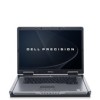Dell Precision M90 User Guide - Page 100
IEEE 1394 Device Problems, Keyboard Problems
 |
View all Dell Precision M90 manuals
Add to My Manuals
Save this manual to your list of manuals |
Page 100 highlights
NOTE: The ExpressCard slot does not support PC Cards. Check the ExpressCard - Ensure that the ExpressCard is properly inserted into the connector. Ensure that the card is recognized by Windows - Double-click the Safely Remove Hardware icon in the Windows taskbar. Ensure that the card is listed. If you have problems with a Dell-provided ExpressCard - Contact Dell. See Contacting Dell. If you have problems with an ExpressCard not provided by Dell - Contact the ExpressCard manufacturer. IEEE 1394 Device Problems CAUTION: Before you begin any of the procedures in this section, follow the safety instructions in the Product Information Guide. Ensure that the IEEE 1394 device is recognized by Windows - 1. Click the Start button and click Control Panel. 2. Click Printers and Other Hardware. If your IEEE 1394 device is listed, Windows recognizes the device. If you have problems with a Dell-provided IEEE 1394 device - If you have problems with an IEEE 1394 device not provided by Dell - Contact Dell (see Contacting Dell) or the IEEE 1394 device manufacturer. Ensure that the IEEE 1394 device is properly inserted into the connector Keyboard Problems CAUTION: Before you begin any of the procedures in this section, follow the safety instructions in the Product Information Guide. Fill out the Diagnostics Checklist (see Diagnostics Checklist) as you perform the various checks. External Keyboard problems NOTE: When you attach an external keyboard, the integrated keyboard remains fully functional. Check the keyboard cable - Shut down the computer. Disconnect the keyboard cable and check it for damage, and firmly reconnect the cable. If you are using a keyboard extension cable, disconnect it and connect the keyboard directly to the computer. Check the external keyboard - 1. Shut down the computer, wait 1 minute, and turn it on again. 2. Verify that the numbers, capitals, and scroll lock lights on the keyboard blink during the boot routine. 3. From the Windows desktop, click the Start button, point to All Programs® Accessories, and then click Notepad. 4. Type some characters on the external keyboard and verify that they appear on the display.















